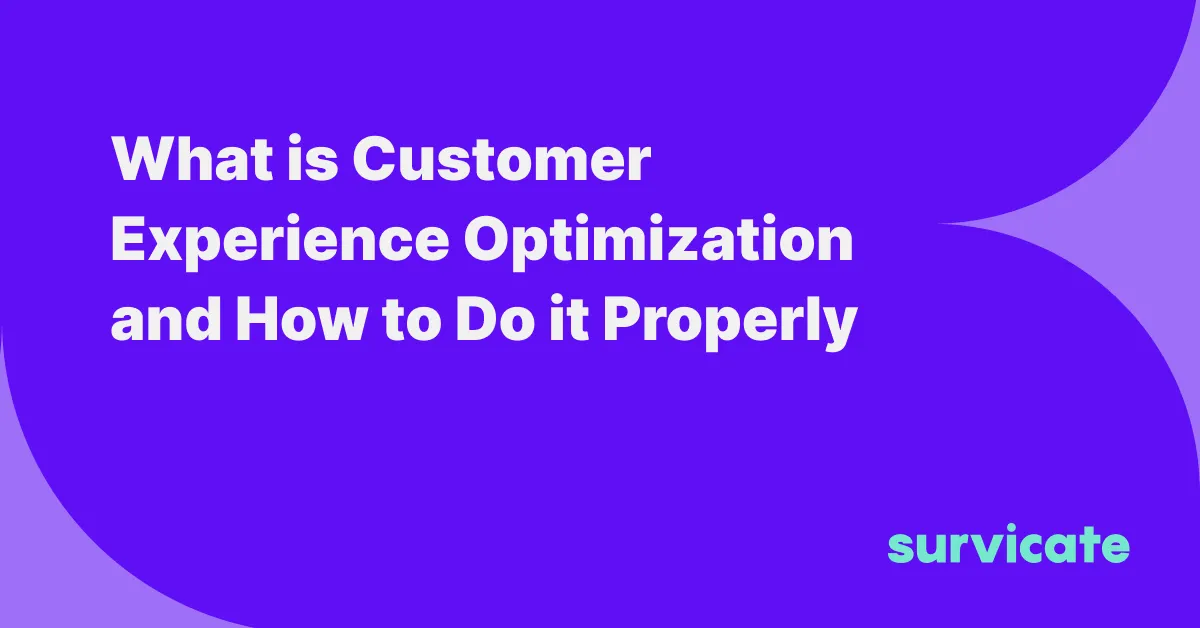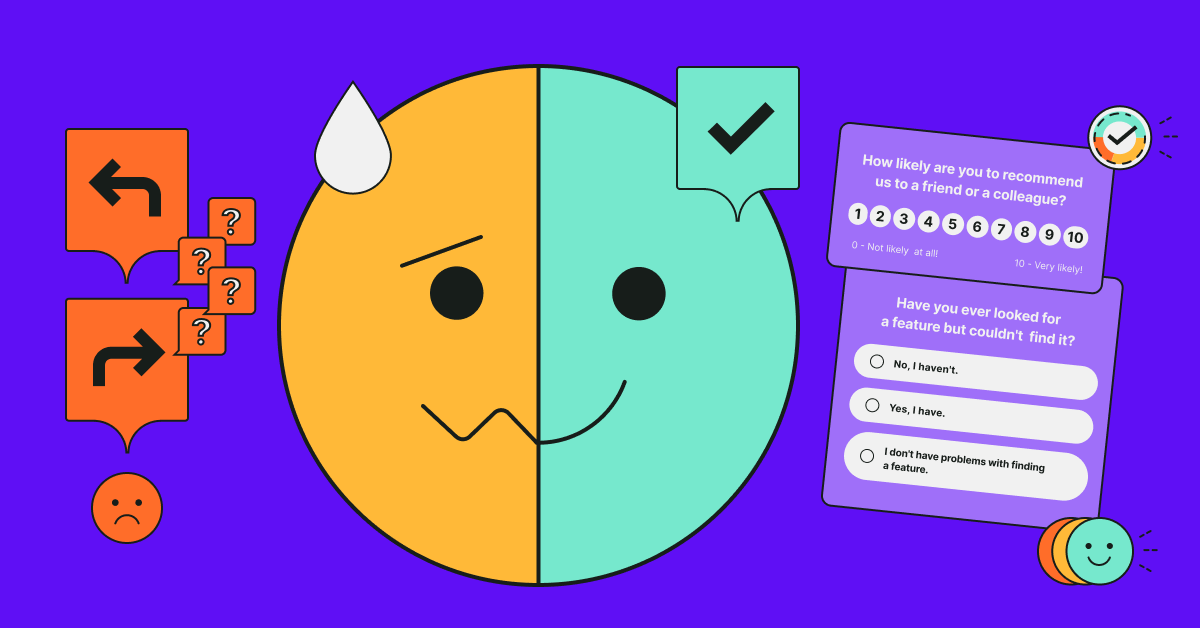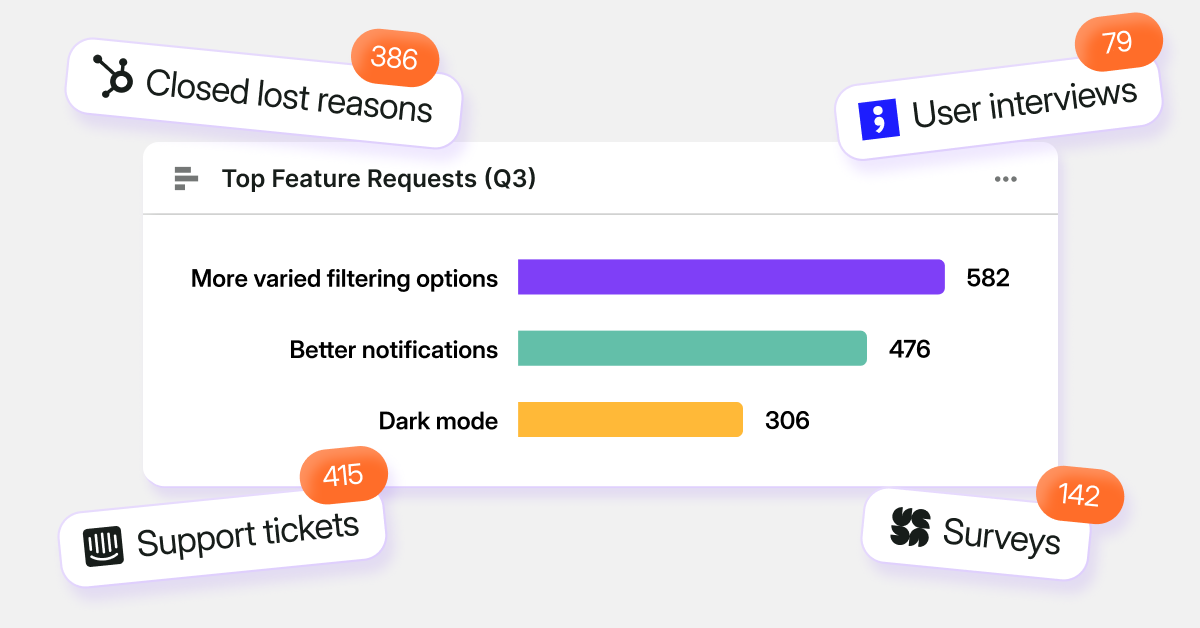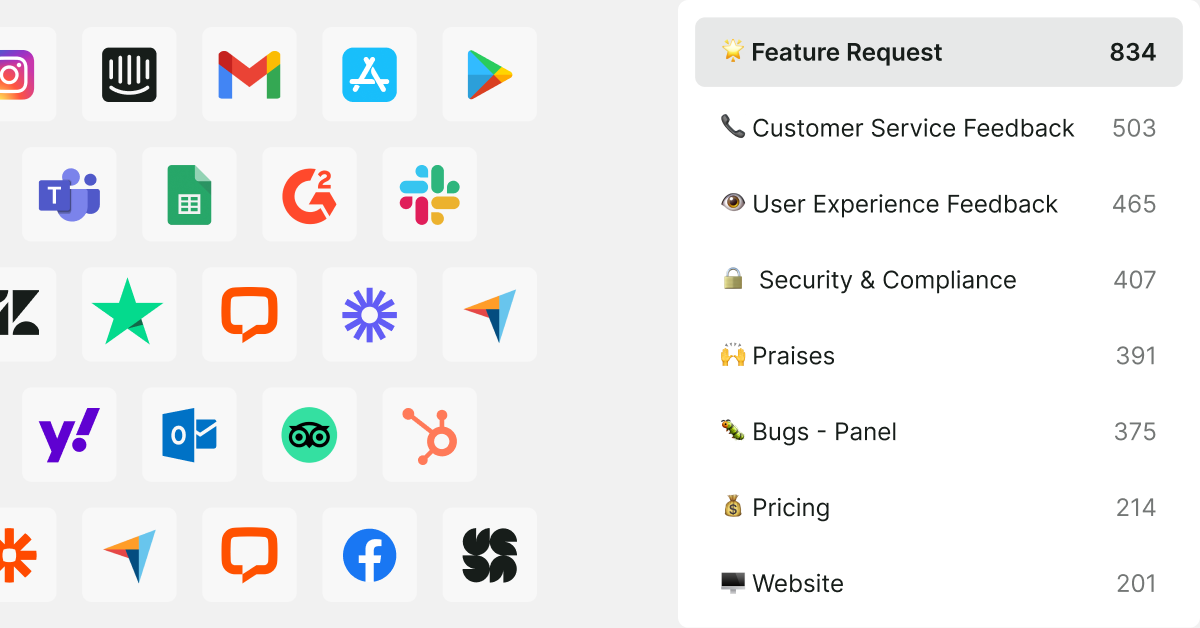Tl;dr;
- Customer touchpoints are crucial: Every customer interaction, from the first ad to post-purchase support, is an opportunity to influence customer's perception and build a lasting relationship.
- Customer journey mapping is key: Creating a customer journey map is essential to visualize and understand all the touchpoints, allowing for strategic improvements and a seamless customer experience.
- Feedback fuels optimization: Regularly collecting customer feedback, especially through online surveys, is invaluable for understanding customer needs and staying ahead of competitors.
- Personalization improves digital CX: Using CRM systems to personalize interactions and segmenting customers for targeted communication are powerful ways to make each touchpoint more impactful.
- Closing the loop is mandatory: Act on the feedback received to improve touchpoints and communicate these changes back to the customers, reinforcing that their opinions lead to real enhancements.

What is a customer journey touchpoint?
A customer journey touchpoint is any instance where you, as a customer, come into contact with a brand during your buying journey. These touchpoints cover the full spectrum of interactions, from the first moment a brand sparks your interest to the post-purchase experience and beyond.
Customer journey touchpoint examples include:
- Discovering a product through an advertisement.
- Visiting a website, influenced by content such as blogs or marketing campaigns.
- Interacting on social media, where you might ask questions or view promotions.
- Customer service interactions, through channels such as email, phone, or online chat.
- Engaging with physical elements like stores or packaging.
- Post-purchase follow-up, such as feedback requests or loyalty programs.
Each touchpoint reflects an opportunity for a brand to shape your perception and influence your decisions. It's important to recognize that these interactions are not isolated; they collectively contribute to your overall experience with a company.
Crucial touchpoint characteristics:
- Accessibility: How easy is it for you to find and engage with the touchpoint?
- Relevance: Does the touchpoint provide you with value or meet your needs at that moment?
- Consistency: Is the brand delivering a uniform experience across all touchpoints?
Managing customer journey touchpoints effectively means you must align them closely with the needs and preferences of your target audience.
Why is it crucial to identify customer journey touchpoints?
Identifying customer journey touchpoints is essential because it allows you to understand how customers interact with your brand at every stage of their journey. It can enhance customer experience, boost customer satisfaction, and ultimately increase customer loyalty.
- Map the customer journey: By identifying touchpoints, you gain insight into the actual paths customers take, which may not be linear. This map is a tool for visualizing the customer experience, from awareness to post-purchase.
- Identify areas for improvement: Recognizing touchpoints enables you to discover your customers' pain points. Consequently, you can focus your efforts on improving those specific interactions.
- Align across teams: When all parts of your organization are aware of the touchpoints, there's better alignment on where to invest resources for the greatest impact on customer experience.
- Measure satisfaction accurately: Knowing your touchpoints allows for more targeted feedback collection, leading to more accurate measurements of customer satisfaction.
By identifying and improving these touchpoints, you can better shape positive perceptions of your brand. You have to remember that it's not just about individual interactions but how they cumulatively build the overall customer experience.
Customer touchpoint vs. customer journey
When you analyze the customer experience, you differentiate between customer touchpoints and the customer journey. Touchpoints refer to the individual interactions that a customer has with your brand at any stage and through any channel.
These can range from viewing an advertisement to visiting your website or calling customer service.

The customer journey, however, represents the aggregate of these touchpoints as a cohesive narrative. It's the entire process a customer goes through, encompassing all touchpoints leading to final actions like a purchase.
Unlike touchpoints, the customer journey provides a broad perspective, highlighting how each interaction fits into the larger purchasing process.
Here's an example to clarify:
- Customer touchpoint: A customer sees an ad for your product on social media.
- Journey: The same customer clicks the ad, browses your site, adds a product to the cart, and completes a purchase.
Your goal in understanding these concepts is to optimize each touchpoint and ensure they collectively contribute to a smooth and satisfying customer journey.
Keep in mind, focusing too heavily on individual touchpoints without considering the full journey may lead to a disjointed customer experience.
Types of customer touchpoints
Customer touchpoints encompass all the different ways you interact with a brand before, during, and after making a purchase. They shape the overall customer experience and perception of your brand.

Pre-purchase touchpoints
The journey with a brand often begins with an encounter—be it through a social media ad, a search engine result, or a recommendation from a friend. This sparks curiosity, leading to a research phase where we scour the company's website and read through customer reviews to assess the product's fit for our needs.
As interest builds, engagement follows; we interact with the brand's online content and may reach out to customer service for further inquiries. This progression from awareness to active engagement shapes our perceptions and guides our purchasing decisions.
Social Media: Platforms where brands can engage with potential customers through content, ads, and direct messaging.
Online ads: Targeted ads that appear on various digital platforms, aimed at capturing the attention of potential customers.
Digital marketing content: Informative blog posts, whitepapers, and e-books that provide value and establish brand authority.
Company events: Webinars, workshops, and conferences that offer networking opportunities and firsthand experience with the brand.
Peer referral: Word-of-mouth recommendations from friends or family, a powerful influencer in the decision-making process.
Video content: Product explainers, tutorials, and testimonials that visually showcase the brand's offerings.
Product demos: Interactive sessions that give potential customers a feel for the product's capabilities.
Online reviews and forums: Platforms where prospective customers read about others' experiences and form opinions about the brand.
During purchase touchpoints
Choosing a product is a key touchpoint in the customer journey during the purchase stage. This leads to the transaction, where a simple checkout process is crucial. Clear prompts like 'Add to Cart' or 'Checkout' guide the customer.
At the same time, readily available customer service is essential for addressing any questions or problems. This part of the journey is vital for a smooth shift from considering a product to actually buying it, and it greatly affects the customer's overall experience.
Company website pages: The brand's digital storefront where customers find information and make decisions.
Pricing information: Clear and accessible pricing details that help customers understand the value proposition.
Product pages and catalogs: Detailed descriptions and images that help customers evaluate products.
Online or in-store transactions: The actual purchase process, whether digital or physical, should be seamless and user-friendly.
Checkout process and payment experience: A straightforward and secure process that leaves a positive impression.
Customer interactions with sales representatives: Personalized assistance that can sway purchasing decisions.
Post-purchase touchpoints
After completing a purchase, the journey continues with follow-up communication. Customers typically receive a confirmation email or text that provides important details about their order. As the product is on its way or the service begins its implementation phase, the ability to track progress becomes a reassuring touchpoint.
Post-purchase, support, and maintenance are crucial; customers should have access to self-help resources such as knowledge bases, as well as direct support for any additional needs that arise. It is essential in securing customer satisfaction and loyalty, making it a pivotal point in the customer journey.
Product feedback surveys: Tools to gauge customer satisfaction and gather insights for improvement.
Feedback survey: An opportunity for customers to share their post-purchase experience and for the brand to listen.
Upselling/cross-selling: Personalized communications offering additional products that complement the initial purchase.
Renewals: Reminders and incentives for customers to continue their relationship with the brand.
Newsletter: Regular updates that keep the brand top-of-mind and inform customers about new offers.
Customer Support touchpoints
Customer Success program: Initiatives designed to ensure customers achieve their desired outcomes using the product or service.
Customer onboarding: Guidance provided to new customers to help them get the most out of their purchase.
Customer loyalty programs: Rewards and benefits that encourage repeat purchases and brand advocacy.
Self-service resources: Knowledge bases, FAQs, and tutorials that empower customers to find solutions independently.
By meticulously managing each touchpoint, you can create a cohesive and satisfying customer journey that builds loyalty and encourages repeat business.
How to identify customer touchpoints?
Identifying customer touchpoints is essential for understanding the stages where prospects and clients interact with your brand. This empowers you to enhance their experience and ultimately drive loyalty and sales. Here's a structured approach:
Assess customer interactions and needs
Begin by putting yourself in your customers' shoes. Analyze their behavior, preferences, and pain points. This understanding will help you anticipate where they are most likely to engage with your brand.
Create customer journey maps
Customer journey mapping visually represents every stage a customer goes through with your brand. From initial awareness to post-purchase, this map will highlight key interactions that could influence their decision-making process.
Examine where and how customers engage with your brand
Take a closer look at the various ways customers interact with your business. Review data from your website analytics, social media platforms, and other channels where customers may seek information or communicate with your brand.
Organize all important customer touchpoints
Make a comprehensive list of all the touchpoints you've identified. Organize them into categories such as 'pre-purchase', 'during purchase', and 'post-purchase' to get a clearer picture of the customer journey and to pinpoint areas for improvement.
How to use customer touchpoints in your business?
Customer touchpoints are key interactions between your business and customers, shaping their journey and determining their loyalty to your brand. Optimizing these touchpoints is crucial because it significantly influences the customer's experience and perception of your company.
Identify touchpoints: Firstly, map out all the instances where customers come into contact with your brand, which can include:
- Pre-purchase: Advertising, social media presence, customer reviews.
- Purchase: Sales calls, checkout processes, e-commerce platforms.
- Post-purchase: Follow-up emails, customer support, user guides.
Optimization strategies:
- Simplify the checkout process: Streamline your online checkout to minimize steps and ask for only necessary information to avoid cart abandonment.
- Improve customer support: Ensure access to assistance through an easily navigable customer service portal or a readily available phone number.
- Resource accessibility: Provide a comprehensive knowledge base and how-to guides, enabling customers to help themselves.
Analyzing and improving
- Collect feedback: Use surveys to understand customer satisfaction at various touchpoints.
- Act on Data: Implement changes based on the insights you gain to improve the customer journey continually.
By focusing on these areas, you'll improve not only individual interactions but the entire customer journey. Remember, every touchpoint is an opportunity to build a stronger relationship with your customers.
How to optimize customer touchpoints
Optimizing customer touchpoints is about refining customer interactions with your brand. Here's how you can use touchpoints to build a better customer journey.
Collect customer feedback with online surveys
Online surveys are powerful tools for collecting customer feedback. They can help you understand customer preferences and pain points. They're easy to deploy and gather feedback quickly at scale.
To enhance your customer's journey, use online surveys at various touchpoints. Here's how:
Identify key touchpoints: Begin by pinpointing crucial interactions in the customer journey—this may include website navigation, checkout, or customer service encounters.
Integrate surveys effectively: Embed surveys directly into these touchpoints. Post-interaction pop-ups or email follow-ups can yield high response rates. Consider this structure:
- Pre-Purchase: Would you say our product range is adequate?
- Post-Purchase: How satisfied are you with the checkout process?
Keep surveys short: Restricting your surveys to a few pertinent questions will improve completion rates. Aim for questions that gauge both satisfaction and expectation.
- How easily could you find what you were looking for? (Rate on a scale of 1-5)
- Was the checkout process straightforward? (Yes/No)
Tak advantage of real-time feedback: Quick, actionable responses allow for immediate improvements. Automated tools can flag issues that require swift attention.
Analyze and act: Aggregate feedback and identify patterns. This will inform actionable changes to refine the customer experience.
- High Satisfaction: Build on these areas.
- Low Satisfaction: Address immediately.
Close the feedback loop
Collecting feedback is not enough; you must act on it and let customers know their input has led to change. This is probably the best way to demonstrate to your customers that their opinions are valued and taken seriously.
Examples: Follow-up emails detailing changes from survey results or personalized responses to individual feedback.
Personalize customer interactions
Tailoring personalized interactions can significantly enhance the customer experience.
- Use a CRM: A Customer Relationship Management system can track customer preferences and history, enabling personalized service.
- Segment your customers: Group customers based on behavior or demographics to tailor communications.
- Dedicated communications: Send targeted offers, information, and acknowledgments that resonate with individual customer segments.
By systematically collecting and implementing feedback, personalizing interactions, and closing the loop with customers, you can significantly improve the quality of customer touchpoints.
Each of these strategies requires a commitment to listening to and valuing customer input, as well as using that information to make meaningful improvements in the customer journey.
To wrap it up, understanding and optimizing customer journey touchpoints is fundamental to enhancing the customer experience. The key to achieving this lies in gathering actionable feedback and using it to make informed improvements.
Survicate offers a comprehensive solution for collecting customer insights through targeted surveys at each touchpoint of the journey. With its intuitive design and powerful analytics, Survicate captures the customer's voice, closes the feedback loop, and personalizes interactions like never before.
Take the first step towards a transformed customer experience, and try Survicate for free with a 10-day trial of all Business Plan features.

Customer touchpoints FAQs
Before diving into specific queries, you should understand that a customer journey map is a visual representation of all customer interactions with a brand, from awareness to post-purchase, and touchpoints are those individual points of contact.
What are the key components of an effective customer journey map?
An effective customer journey map includes customer stages, touchpoints and channels, emotions, and opportunities for improvement. It provides a diagrammatic representation that helps you visualize the path of engagement with your brand.
How do customer touchpoints impact the overall customer experience?
Customer touchpoints, being the specific interactions your customers have with your brand, significantly influence customer satisfaction and loyalty. Each touchpoint can affect the overall perception of your brand, making consistent, positive experiences crucial.
Can you list the stages of the customer journey and associated touchpoints?
The stages of the customer journey typically comprise awareness, consideration, purchase, retention, and advocacy. Associated touchpoints range from online ads and search results to in-store experiences and customer service interactions.
What strategies are most effective for optimizing customer touchpoints?
To optimize customer touchpoints, analyze customer feedback, map out the entire journey, identify pain points, and personalize interactions. Additionally, leverage technology to enhance digital touchpoints and ensure staff are well-trained to provide exceptional service.
How do you measure the success of interactions at customer journey touchpoints?
Success at customer journey touchpoints is measured by customer satisfaction scores, conversion rates, repeat purchase rates, and net promoter scores. Data analytics can also reveal the effectiveness of each touchpoint, guiding improvements.
What role do digital touchpoints play in shaping the customer journey?
Digital touchpoints play a significant role in shaping the customer journey by providing convenience, personalization, and a seamless transition between online and offline experiences. They’re critical in today's digital-first environment where many customers initiate their journey online.








.webp)






.svg)

.svg)


